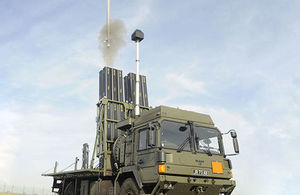Niteworks 3: Improving Ground Based Air Defence
Improving Ground Based Air Defence (GBAD) through supporting a GBAD Capability Integration Plan and a pan Defence Lines of Development (DLOD) GBAD Programme.

The pictures shows a full scale Land Ceptor Missile System.
Background
The Joint Sensor and Engagement Networks Delivery Team (JSENS DT) is responsible for the delivery of the Future Force Ground Based Air Defence and Air Surveillance programme (FF GBAD AS). The first phase will provide a Battle Management, Command, Control, Computers, Communications and Intelligence (BMC4I) system integrated with the Land Ceptor Missile System and ground based radars to provide an integrated safe and effective ground based defence.
To avoid a capability gap a procurement exercise was conducted against demanding timescales. Fundamental to the success of the procurement strategy was the creation of robust and independent, industry informed System Requirements Document (SRD).
Niteworks Task
The Delivery Team identified Niteworks as unique in being able to deliver wide industry participation and giving industry subject matter experts a chance to contribute. The team wanted to draw from industry’s GBAD experience in establishing system requirements, whilst also gaining an understanding of what the military user required. Niteworks was initially tasked to provide a draft SRD informed by Military Judgement Panels and industry workshops and, via Operational Analysis (OA), provide a sensor performance criteria document. These documents were to be supported by a high level architecture and a Safety Hazard Assessment (SHA).
Following the success of this first phase of work, Niteworks was then tasked with Phase 2: to support the creation of a GBAD capability integration plan by conducting research into the Defence Lines of Development (DLODs) to ‘kick-start’ the development of the comprehensive DLOD GBAD Programme.
Customer, GBAD Project Manager, DE&S:
The project required a comprehensive input from industry and military judgement panels to derive a GBAD SRD in an extremely short timeframe.
How did Niteworks approach the task?
Extensive engagement with the military stakeholder community and with industry enabled the team to validate the approach, assumptions, and requirements.
Across the two phases, the Niteworks team hosted seven Military Judgement Panels in order to derive detailed user requirements. The team planned and facilitated five well supported Industry Workshops, collaborated extensively with the Capability Integration Group and organised a number of working sessions in each DLOD area. Informed OA was also undertaken to assess GBAD system performance timelines to inform SRD Measures of Performance.
Draft output documents were circulated regularly to the military stakeholder community and to industry to confirm that the requirement set was realistic and appropriate. Industry was able to give meaningful feedback on how the capability could be developed within an extremely short timeframe.
The project delivered:
- a detailed, industry informed input to the SRD including measures of performance derived from OA
- proposals for the supporting governance framework
- coherent programme management artifacts
- a DLOD study addressing the new personnel and training issues needed for a Beyond Line of Sight capacity
- a sensor options study
- a Safety Hazard Assessment
What was the outcome?
The project significantly raised the level of understanding in the Delivery Team and military community in topics such as safety, radar and missile system performance and the related architectural implications. This enabled the Delivery Team to deliver a rigorous and comprehensive SRD as part of the procurement exercise. Industry contribution to the SRD improved their understanding of the Ministry Of Defence’s (MOD) requirements and allowed them to consider how they could best contribute to meeting the needs of defence.
The Niteworks project allowed the Delivery Team to successfully compete the replacement capability with a set of artefacts that included an industry informed set of requirements, architectures and a capability integration plan covering the DLODs.
As a result, the contract to provide the capability was awarded less than 30 months from the start of the first Niteworks project.
What were the benefits?
Customer, GBAD Project Manager, DE&S:
The range of expertise which Niteworks could draw upon as a result of the industry partnership is unparalleled and is not something DE&S could replicate.
- a Delivery Team with improved understanding of the key issues, options and appreciation of the art of the possible
- in less than 12 months the Delivery Team created an endorsed User Requirements Document and submitted an SRD to MOD Scrutiny for approval for a highly complex system
- improved value for money was achieved by conducting a full competition, rather than a sole source strategy or limited competition. (Some industry partners stated that they would not have participated in the competition if it had not been for the Niteworks project)
- sharing the basis for the SRD with industry to inform their understanding of requirements provided a sound base for the competition and gave confidence in the MOD’s commitment to the project
- industry obtained a comprehensive view of what was required and how this was to be supported through life
- a more effective GBAD capability will be available due to the additional networked capability enabled by an open architecture
- safer capability due to drawing upon industry best practice to ensure that all the latest safety measures are incorporated
- the open architecture will reduce the risk and cost of integrating new equipment in future